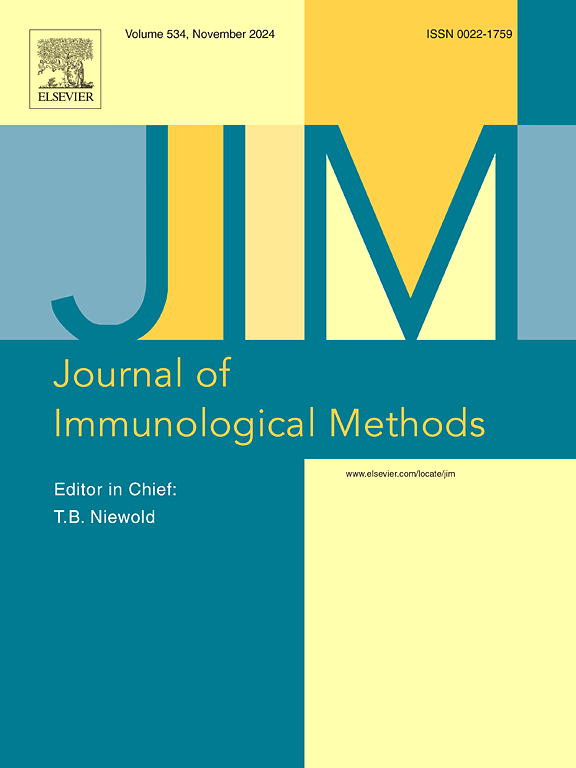二价阳离子和SERPIN基因表达调控LPS诱导马蹄蟹凝血
IF 1.6
4区 医学
Q4 BIOCHEMICAL RESEARCH METHODS
引用次数: 0
摘要
马蹄蟹(Tachypleus gigas)具有独特的免疫系统,可用于酶研究,特别是在凝血研究中。这些螃蟹的凝固过程涉及丝氨酸蛋白酶。然而,这些酶及其抑制剂如何在脂多糖(LPS)诱导下调节凝血尚不清楚。本研究旨在探讨二价阳离子和pH对野生和圈养马蹄蟹血液中胰蛋白酶样丝氨酸蛋白酶凝胶化和蛋白水解活性的影响。比较了Tachypleus amoebocyte lysate (TAL)的蛋白谱,测定了LPS诱导下SERPIN基因的表达。使用的方法包括凝胶凝血法评估凝胶作用,SDS-PAGE分析蛋白质,LC-MS/MS鉴定蛋白质,RT-PCR分析基因表达。结果表明,野生马蹄蟹裂解液凝血水平高于圈养蟹。在35种二价阳离子组合中,0.15 M MgCl2 + 0.15 M CaCl2可提高野生TAL的凝血水平。新鲜TAL具有较高的蛋白水解活性,检测到4种主要蛋白。7月份SERPIN基因的表达量比6月份增加了5倍。总的来说,圈养降低了TAL质量和凝血效率。本文章由计算机程序翻译,如有差异,请以英文原文为准。
Divalent cations and SERPIN gene expression modulate horseshoe crab coagulation under LPS induction
Horseshoe crabs (Tachypleus gigas) have a unique immune system used in enzyme research, particularly in coagulation studies. The coagulation process in these crabs involves serine protease enzymes. However, how these enzymes and their inhibitors regulate clotting under lipopolysaccharide (LPS) induction is unclear. This study aimed to examine the effects of divalent cations and pH on the gelation and proteolytic activity of trypsin-like serine protease in wild and captive horseshoe crab blood. It also compared the protein profiles of Tachypleus amoebocyte lysate (TAL) and measured SERPIN gene expression during LPS induction. The methods used included the gel clotting method to assess gelation, SDS-PAGE for protein profiling, LC-MS/MS for protein identification, and RT-PCR for gene expression analysis. Results showed that wild horseshoe crab lysate had higher clotting levels compared to captive crabs. Among 35 divalent cation combinations, 0.15 M MgCl2 + 0.15 M CaCl2 resulted in higher clotting in wild TAL. Fresh TAL had higher proteolytic activity, and four major proteins were detected. SERPIN gene expression increased fivefold in July compared to June. Overall, captivity reduced TAL quality and clotting efficiency.
求助全文
通过发布文献求助,成功后即可免费获取论文全文。
去求助
来源期刊
CiteScore
4.10
自引率
0.00%
发文量
120
审稿时长
3 months
期刊介绍:
The Journal of Immunological Methods is devoted to covering techniques for: (1) Quantitating and detecting antibodies and/or antigens. (2) Purifying immunoglobulins, lymphokines and other molecules of the immune system. (3) Isolating antigens and other substances important in immunological processes. (4) Labelling antigens and antibodies. (5) Localizing antigens and/or antibodies in tissues and cells. (6) Detecting, and fractionating immunocompetent cells. (7) Assaying for cellular immunity. (8) Documenting cell-cell interactions. (9) Initiating immunity and unresponsiveness. (10) Transplanting tissues. (11) Studying items closely related to immunity such as complement, reticuloendothelial system and others. (12) Molecular techniques for studying immune cells and their receptors. (13) Imaging of the immune system. (14) Methods for production or their fragments in eukaryotic and prokaryotic cells.
In addition the journal will publish articles on novel methods for analysing the organization, structure and expression of genes for immunologically important molecules such as immunoglobulins, T cell receptors and accessory molecules involved in antigen recognition, processing and presentation. Submitted full length manuscripts should describe new methods of broad applicability to immunology and not simply the application of an established method to a particular substance - although papers describing such applications may be considered for publication as a short Technical Note. Review articles will also be published by the Journal of Immunological Methods. In general these manuscripts are by solicitation however anyone interested in submitting a review can contact the Reviews Editor and provide an outline of the proposed review.

 求助内容:
求助内容: 应助结果提醒方式:
应助结果提醒方式:


